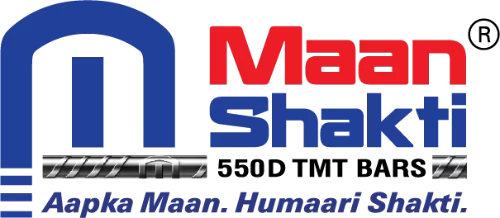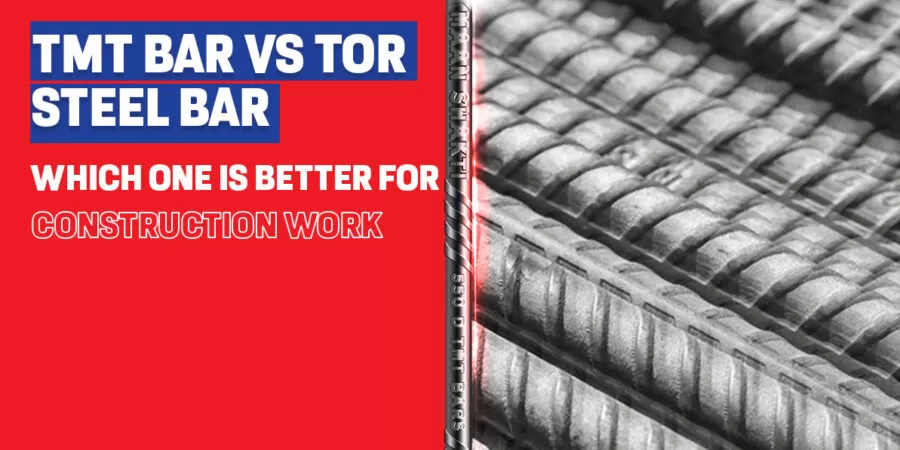Steel bars are one of the most essential materials used in construction works. While combing with concrete, these bars significantly increase the overall strength of a structure. The two most popular options for reinforcing concrete in construction projects are TMT (Thermo Mechanically Treated) bar and TOR (Twisted Old Reinforcement) steel bar. While both serve the same purpose of strengthening the structure, they differ in various aspects. Here we will differentiate various aspects of TMT and TOR steel bars and discover which is better for construction work.
TMT Bar VS TOR Steel Bar
Thermo-Mechanically Treated (TMT) Bars are high-strength reinforcement bars known for their enhanced strength, superior ductility, corrosion resistance, and cost-effectiveness. They are one of the best-known construction materials enhancing the overall integrity and durability of a structure. They provide structural support for buildings to withstand various loads, such as compressive, tensile, and bending stresses. The earthquake-resistant TMT bars give protection to building structures against earthquake forces as well.
Twisted Old Reinforcement (TOR) steel bars are a form of HYSD steel, where the steel bars become cold-twisted and deformed after a heat treatment process. From the 70s to the 90s, TOR steel has been one of the best grades of steel used in concrete reinforcement as high tensile steel.
Manufacturing Process:
TMT bars are made from high-strength steel and undergo a different manufacturing process. It involves three crucial stages: hot rolling, quenching, and self-tempering. First, the steel billets are heated to a high temperature and then passed through a series of rolling mills, forming a thin steel strip. The strip is then cooled rapidly using water jets, known as quenching, to harden the outer surface. Finally, the bars are allowed to self-temper by reheating them, which creates a soft and ductile inner core while maintaining a solid outer layer.
TOR bars are made from mild steel, and the manufacturing process involves twisting or cold twisting of the steel wire rods. The rods are mechanically twisted to increase their tensile strength. The twisted steel rods are then used to create TOR bars, commonly available in 6mm to 25mm diameters.
Higher Tensile Strength
TMT bars possess higher tensile strengths when compared to TOR bars. For applied loads on structural elements, superior quality steel TMT bars result in lower steel content, whereas TOR steel results in 20% higher steel content. If the total steel consumption in a project using TMT bars is 200 tonnes, similarly using TOR steel, it will be 240 tons. Thus, using TMT bars will result in a massive saving of 40 tons of steel.
Superior Ductility:
The ductility of a steel bar suggests the ability of the structural element to deform without collapsing after reaching a failure load. When comparing two steel bars, TMT bars are superior to TOR steel bars. During manufacturing, the quenching and tempering process imparts toughness to the TMT bars, making them suitable for construction in seismic zones. Additionally, TMT bars also possess extraordinary strength, which allows them to help a building structure acquire 20% extra strength. On the other hand, TOR bars have comparatively lower strength and ductility.
Elongation
Elongation refers to the ability of a material to elongate before failure. It plays a significant role in the ductility of steel bars. When compared to TOR steel, TMT bars possess better elongation capability. The hard outer layer and soft inner core of TMT bars can elongate in a way that makes the building structure strong and flexible, protected against the risk of natural calamities like earthquakes, etc.
Bendability
The bendability of a steel bar is another property that plays an important role in helping to keep the structure stay firm. Compared to TOR steel bars, TMT bars have higher ductility. The soft inner core of TMT bars possesses excellent elasticity, which allows them to be bent further to achieve different shapes. This makes them one of the easiest materials to work with that can be bent and molded into any shape during a construction project.
Weldability:
TMT bars are highly weldable with lower carbon content than TOR steels. The low carbon content of TMT bars makes them an effective choice for trouble-free welding work. Moreover, earthquake-resistant TMT bars do not require any pre- or post-casting treatment, which makes them easy for manufacturing purposes. Thus, structural designers and architects can create innovative structures without compromising the quality and strength of TMT bar structures.
Corrosion Resistance:
TMT bars have better corrosion resistance due to a protective oxide film on their surface, which forms during the quenching process. The film serves as a barrier against corrosive elements and enhances the longevity of the bars. TOR bars, made of mild steel, are more susceptible to corrosion and require additional protective measures, such as proper coating or concrete cover.
Fire Resistance
When considering thermal stability, TMT bars are more fire-resistant than TOR bars. TMT bars can retain more than 80% of the yield strength at an ambient temperature of 400- 600 degrees Celcius, keeping your building structure safe and secure during a fire emergency.
Bonding
TMT bars show improved bond strength with cement when compared to TOR steel. This is due to the ribs that run along the surface of the TMT bars, providing superior bonding ability that leads to a stronger structure and increased longevity. Combined with superior strength, TMT bars are ideal for creating structurally sound and long-lasting concrete or cement structures.
Applications:
TMT bars are preferable for high-rise buildings, bridges, dams, industrial structures, and earthquake-prone areas. The excellent strength, ductility, and seismic resistance properties of superior-quality TMT bars make them suitable for structures where safety and durability are paramount.
TOR bars find application in low-rise buildings, residential construction, small-scale projects, and non-seismic zones where the structural requirements are less demanding. They are widely used in the construction of residential houses, boundary walls, and smaller structures where moderate strength is sufficient.
Conclusion:
In summary, both TOR and TMT bars play vital roles in reinforcing concrete structures, but they differ significantly in terms of their manufacturing processes, properties, and applications. TMT bars offer superior strength, ductility, corrosion resistance, and seismic resistance, making them ideal for large-scale construction projects, and therefore a more ideal choice for your construction work. If you seek reliable TMT bars, you must consider Maan Shakti TMT rebars for your upcoming construction work.


Leave a Reply